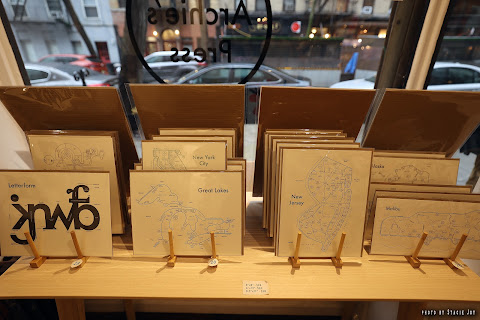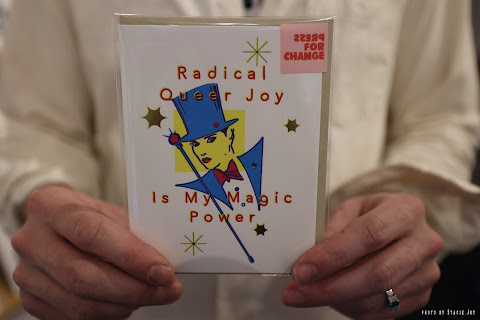Text and photos by Stacie Joy
I’m eager to meet Archie Archambault, the mind behind Archie’s Press, a newly opened letterpress-printed retail art and map shop at 219 E. 10th St between First Avenue and Second Avenue.
An East Village resident as well, Archie greets me at the shop before business hours, shows me the prints, maps, and pressed art pieces, and patiently answers my questions about the letterpress machine and process, his conception and design methods, and what’s it’s been like opening a retail space during the pandemic.
Can you provide a brief primer on letterpress — including the part about potentially crushing every bone in your hand?
Between 1492-1980, anything printed for mass consumption was produced using letterpress technology. Every size of every font was cast in little metal letters that were strung together and printed into advertisements, newspapers, books…everything. For disseminating information, this was the most important technological development until the internet.
EV Grieve would be typeset by hand if it was around in the 1970s. [Ed note: YES!]
Digital typesetting made it mostly obsolete and many presses were left to rot or destroyed. In the late 1990s, people started rehabbing presses to make beautiful stationery and art books. Letterpress actually presses the design into the paper, leaving a strong indentation. It’s up to 600 pounds of pressure, which can easily crush every bone in your hand — watch out!
How did your interest in letterpress come about?
I took a letterpress course in college and got hooked. I’m not sure exactly why. It’s a very “liberal arts” craft. It’s composed of words, so you become a poet. The type needs to be laid out so you become a designer. The colors need to be mixed, so you become an artist. The press is going to break, so you become a mechanic.
There are so many different parts of the brain at work when executing a project. I’m impatient, so it forces me to slow down, think carefully, and stay cool when things don’t go smoothly. When I started selling my work, it became my full-time job, and I haven’t looked back.
Please tell us a little about the Vandercook SP-15 that you use in the shop.
This model is the lightest flatbed press available at about 700 pounds. It was designed to make one perfect copy of something like a newspaper sheet using hand-set type. That one perfect copy would be made into a film for offset printing, which runs very quickly (it’s the machine you see in old movies during newspaper montages).
Remember, there were no computers, so this was the only way to get that one perfect copy. Vandercooks are the most common flatbed presses for doing larger letterpress prints because they are reliable and bulletproof. My press operates without a motor, so it can be used during the apocalypse, which is exciting.
What’s the concept behind your city/state maps?
New research indicates we’re underutilizing the navigational parts of our brains because of GPS. Turns out that’s a problem. This is a hugely powerful part of our brains. When was the last time you felt so lost you thought, “uh oh?” Google Maps is constantly coming to the rescue.
I’m trying to explain the city in the major gestural terms on a map that taps into the “map from the mind.” There’s a great book called “Image of the City” by Kevin Lynch that describes our mind’s vision of our urban spaces. We do not think in birds-eye view. We create our mind’s map with pathways, boundaries, landmarks, nodes and neighborhoods.
I try to draw a map that brings all these things together and omits everything else. I want the viewer to engage with the map and feel the city when they explore it. Keeping it simple prevents a “dazzle” effect. Making it beautiful encourages more engagement.
To get to that sharp gestural drawing, I work with people who are from the city to arrange it like it is in their minds. States are much larger areas, which are harder to wrap one’s head around, but still, there are important roads and landmarks in states that keep our minds constantly orienting themselves.
What design vision guides your work?
I have no formal graphic design education, but letterpress is essentially the foundation of graphic design. All the physical rules of letterpress created the visual language we take for granted on our screens. There’s a reason we keep lines evenly spaced. The personality of each font is much louder when it’s cast in metal.
Everything I know about design I learned by typesetting and printing. I do most of my designing on the computer now because it’s so much more efficient, but the vision comes from letterpress. I’ve expanded to many other ideas, all based on organizing information in a way that is simple and beautiful.
Why decide to open a storefront for your products — instead of relying solely on an online operation?
I opened the store for a few reasons: I wanted to start making new work and get people’s reactions right away. Now I can get something from the idea to the shelf within a week rather than months.
After an isolating 18 months due to COVID, I really wanted to see more people and rejoin the community. I live nearby, and I’ve never felt more at home. And I wanted to collaborate with artists and designers, and having a storefront gives me the venue to produce and celebrate their work.
What has been the reaction to the shop so far?
Everyone who comes in is supportive and delighted. Most people who come immediately go for the print racks, flip through every print and then stare at the walls for a while. It’s a feast and everything in the shop is special for one reason or another. I love it when people ask, “Did you make everything in here?” If I did, I would be a wizard.
Why choose the East Village for your shop?
I’ve lived in the neighborhood for five years and love our robust ecosystem of small unique businesses. For some reason, I felt like the East Village would “get it” and appreciate it. I was right! I cannot imagine this shop anywhere else.
Any future plans you care to share?
We’re just starting to take custom print jobs, so if you have a wedding invitation or business cards to get letterpress printed, we’re the place! We’re also starting to collaborate with artists and designers, so we’ll be having a new show every month or two starting in the spring.
You can keep an eye on the presses here.
Store hours:
Monday 1-6 p.m.
Tuesday Closed
Wednesday Closed
Thursday-Friday 1-6 p.m.
Saturday-Sunday noon- 6 p.m.









9 comments:
What a wonderful shop! I'll definitely be stopping by.
I learned typesetting and letterpress printing in school and absolutely loved it. It's an art that I'm glad to see making a comeback. The machine I learned on was from the 1800s and was as tall as me. The possibility of getting crushed with every pull of the lever made every job exciting! I also recommend visiting the print shop down at the Seaport Museum on Water Street where they have a collection of working presses.
There are old buildings all around lower Manhattan with the name “Lithograph” What’s the difference between lithograph and typograph?
Very cool. Need more unique places like this!!!!
Fantastic addition to the neighborhood! Fun stuff.
Amazing!
I need to visit!
@2017Gotham, I think that with lithographs the text is photographed, the image is transferred to a drum, and the drum transfers the image to the paper. With typograph, you actually form the letters out of lead (my grandfather had this job at a small-town newspaper), arrange them in racks, and then insert the racks in the press, and these then press the ink onto the paper.
So nifty! Thank you for including Detroit in your city maps.
What a cool shop! A great addition to our neighborhood!
Love these interviews
Post a Comment